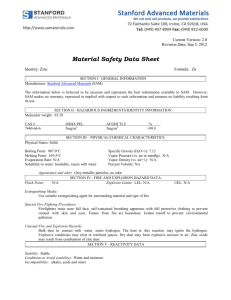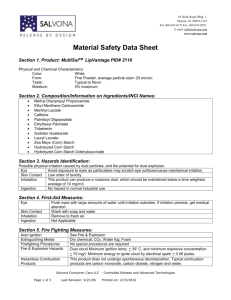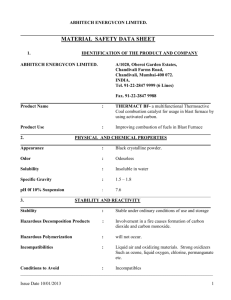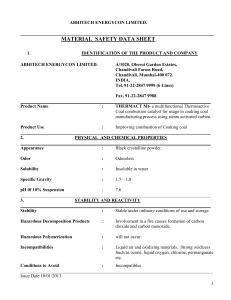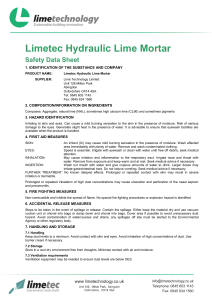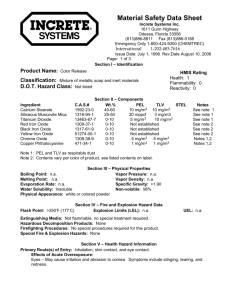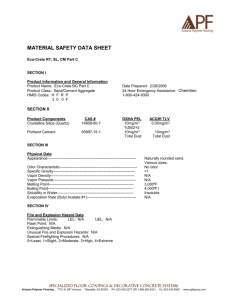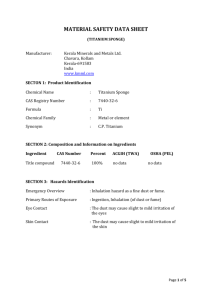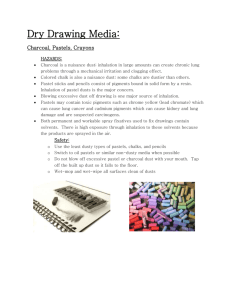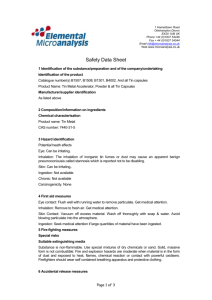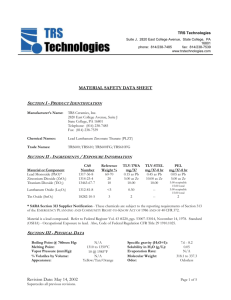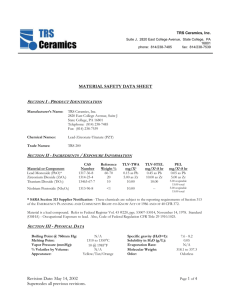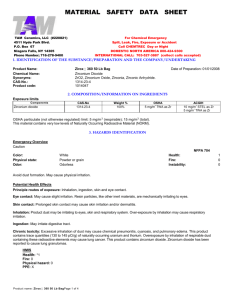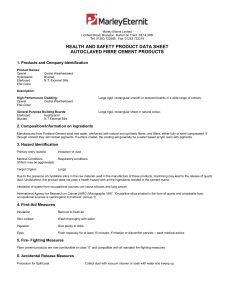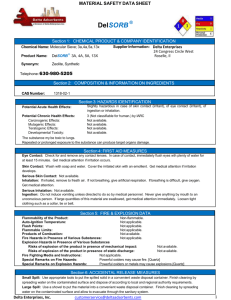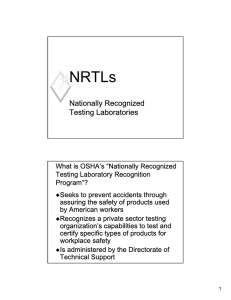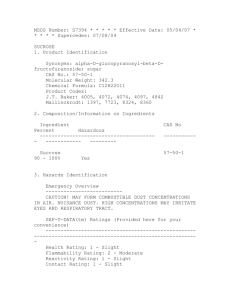Polypropylene MSDS Sheet
advertisement
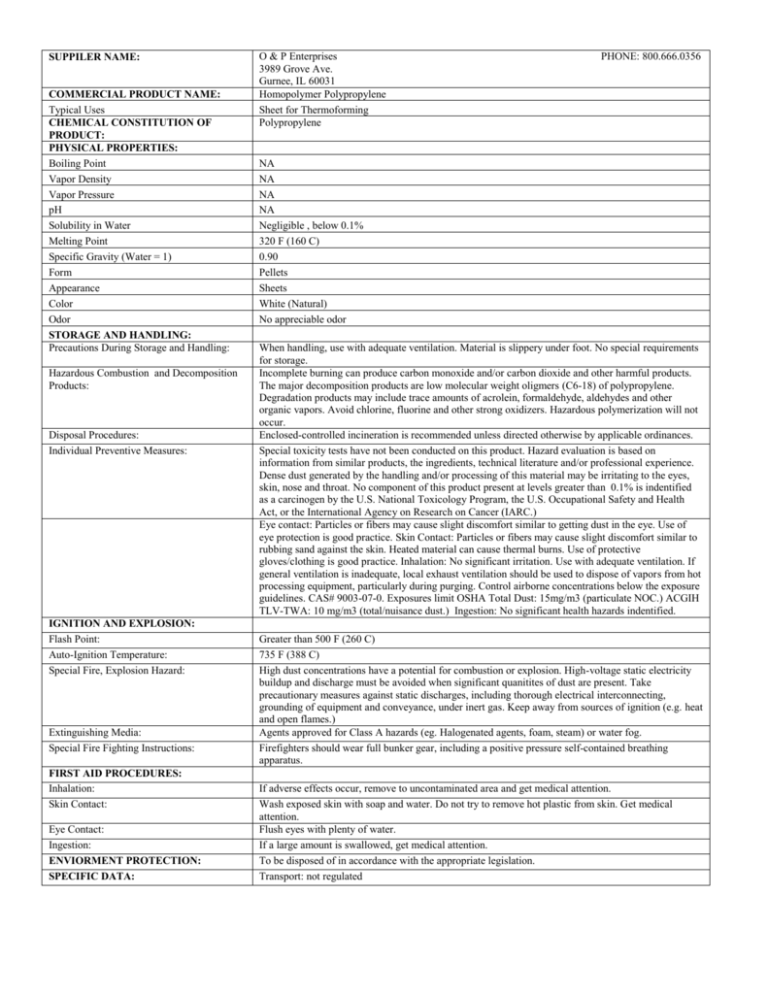
SUPPILER NAME: COMMERCIAL PRODUCT NAME: Typical Uses CHEMICAL CONSTITUTION OF PRODUCT: PHYSICAL PROPERTIES: Boiling Point Vapor Density Vapor Pressure pH Solubility in Water Melting Point Specific Gravity (Water = 1) Form Appearance Color Odor STORAGE AND HANDLING: Precautions During Storage and Handling: Hazardous Combustion and Decomposition Products: Disposal Procedures: Individual Preventive Measures: IGNITION AND EXPLOSION: Flash Point: Auto-Ignition Temperature: Special Fire, Explosion Hazard: Extinguishing Media: Special Fire Fighting Instructions: FIRST AID PROCEDURES: Inhalation: Skin Contact: Eye Contact: Ingestion: ENVIORMENT PROTECTION: SPECIFIC DATA: O & P Enterprises 3989 Grove Ave. Gurnee, IL 60031 Homopolymer Polypropylene Sheet for Thermoforming Polypropylene PHONE: 800.666.0356 NA NA NA NA Negligible , below 0.1% 320 F (160 C) 0.90 Pellets Sheets White (Natural) No appreciable odor When handling, use with adequate ventilation. Material is slippery under foot. No special requirements for storage. Incomplete burning can produce carbon monoxide and/or carbon dioxide and other harmful products. The major decomposition products are low molecular weight oligmers (C6-18) of polypropylene. Degradation products may include trace amounts of acrolein, formaldehyde, aldehydes and other organic vapors. Avoid chlorine, fluorine and other strong oxidizers. Hazardous polymerization will not occur. Enclosed-controlled incineration is recommended unless directed otherwise by applicable ordinances. Special toxicity tests have not been conducted on this product. Hazard evaluation is based on information from similar products, the ingredients, technical literature and/or professional experience. Dense dust generated by the handling and/or processing of this material may be irritating to the eyes, skin, nose and throat. No component of this product present at levels greater than 0.1% is indentified as a carcinogen by the U.S. National Toxicology Program, the U.S. Occupational Safety and Health Act, or the International Agency on Research on Cancer (IARC.) Eye contact: Particles or fibers may cause slight discomfort similar to getting dust in the eye. Use of eye protection is good practice. Skin Contact: Particles or fibers may cause slight discomfort similar to rubbing sand against the skin. Heated material can cause thermal burns. Use of protective gloves/clothing is good practice. Inhalation: No significant irritation. Use with adequate ventilation. If general ventilation is inadequate, local exhaust ventilation should be used to dispose of vapors from hot processing equipment, particularly during purging. Control airborne concentrations below the exposure guidelines. CAS# 9003-07-0. Exposures limit OSHA Total Dust: 15mg/m3 (particulate NOC.) ACGIH TLV-TWA: 10 mg/m3 (total/nuisance dust.) Ingestion: No significant health hazards indentified. Greater than 500 F (260 C) 735 F (388 C) High dust concentrations have a potential for combustion or explosion. High-voltage static electricity buildup and discharge must be avoided when significant quanitites of dust are present. Take precautionary measures against static discharges, including thorough electrical interconnecting, grounding of equipment and conveyance, under inert gas. Keep away from sources of ignition (e.g. heat and open flames.) Agents approved for Class A hazards (eg. Halogenated agents, foam, steam) or water fog. Firefighters should wear full bunker gear, including a positive pressure self-contained breathing apparatus. If adverse effects occur, remove to uncontaminated area and get medical attention. Wash exposed skin with soap and water. Do not try to remove hot plastic from skin. Get medical attention. Flush eyes with plenty of water. If a large amount is swallowed, get medical attention. To be disposed of in accordance with the appropriate legislation. Transport: not regulated

